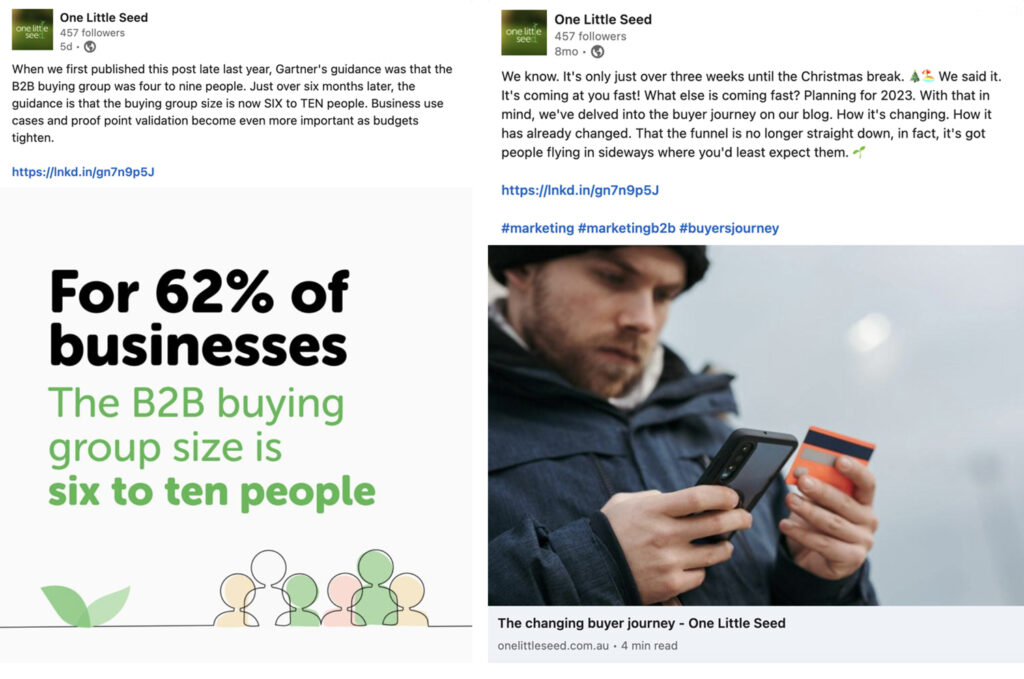Gartner's recent Buyers Journey study increased the buying group size up to six to ten people (up from four to nine in late 2022). And we counted 12 online touchpoints for the buyers group. 6sense talks about the 'dark funnel' and that 78% of your in-market accounts are not in your CRM. This is why content is important: the people in that buying group are generally not visible to you. As marketers, we have plenty of data that tells us what job titles we should be targeting, and with intent data tools, we can go and work out who might be in that buying group within specific organisations. Sure, you can hit them with paid media (that's a topic for another day), and give their phone number to a BDR to cold call. But how do you bring them into your funnel when everyone understands the value of their email address? It starts with (ungated) content.
78% of your in-market accounts are not in your CRM
So, what should those 12 touchpoints look like? What type of content should you be creating? Is all content created equal? The answer to many of those questions is the brand vs. demand generation argument. Your first challenge is to get buyers to know who you are, this is brand awareness. It doesn't matter how fabulous your content and your content strategy is, if people don't know who you are, they won't read or consume it. So, some might say that's the most important piece (pretty sure the sales guy would argue that point).
Where to start for building brand?
- Website
- Thought leadership content
- Social media content
Often, our clients have a website to tick the box when we start working with. And we regularly talk about making them look as professional on the outside as they are on the inside. And to be honest, that was the approach One Little Seed took in the first couple of years. Your website is a potential client's first impression of your business. Take a step back and ask yourself, would I engage with this company based on their website? With millennials and Gen Z now entering the decision-making process, this is now more important than ever. They're more reliant on online research than any of the buyers in the decision-making process.
Take a step back and ask yourself, would I engage with this company based on their website?
When it comes to your website, don't get caught up on your internal language and product names. Think about what your potential customers want to know or the problem they are trying to solve. Selling a cyber security solution? How does it help businesses reduce their risk? Does it improve compliance? Can it reduce the complexity of staff resourcing through automation? Make it easy for prospective clients to find what they need, don't hide it layers deep or behind a form fill.
Thought leadership content. It is about you adding value. Giving something for nothing. Showing prospective customers that you know their industry and pain points. What is the business issue that's keeping your prospective CIO/CISO awake at night? What trends are you seeing from your customers in the same space? It's not about product, it's not about why your widget is better than someone else's widget. It's about starting to build trust and brand awareness.
Good old social media content. This is how you amplify, continuing to add value, and consistency is the key here. The beauty of social media content is that you can promote one blog post multiple times by calling out key messages and changing the imagery. Content is not a one-hit-wonder. It also allows you to easily extend your reach, as the more people that engage by hitting that like button, the more visible your post becomes.

Content is not a one-hit-wonder.
You can also leverage tools with free pricing levels, such as SocialPilot, Hootsuite, Sprout or a myriad of other social media scheduling solutions, which means you can preload your content for the month, so you don't need to think about it.
The other consideration is picking up on newsworthy content. You don't always need to be generating original content. Leveraging other great content shows that you are researching and immersed in the industry.

Have some fun with your social media content. It doesn't always have to be business related. Elevate your people and introduce them to the online world so prospects have a sense of connection when they engage. You'll slowly start to see who the 'voyeurs' in your dark funnel are, as there is less risk of engaging with a fun post than a business-related post. For One Little Seed, our highest engagement posts have been the ones where our team features in photos or we're having fun with our love of Margaritas.
Finally, why is brand important? It is often the hardest thing to measure for marketers. We're all now measured on direct ROI and revenue attribution. How many MQL's are we delivering to the top of the funnel? Why aren't there as many form fills on our website?
The answer is as simple as it is complex. I ask you to put yourself in your buyer's shoes. How often do you think I'm not putting my email address in there because I know it means someone will call me? 99% of the time, we're not ready for that call. We just want some information. We all want to remain anonymous in this digitally tracked world until we're ready to engage.
Brand and thought leadership content allows your early-stage buyers to understand who you are, what your business does, and whether it's the type of business they're going to want to engage with. We know the sales cycle for complex B2B decision-makers is around 6-9 months minimum (in a good year). So, without embracing brand and content, you're missing out on that 72% of buyers who are living in your dark funnel.
Let's be honest, we're all just voyeurs on some buying journey every day. How do you want your buyers' journey to look like vs the experience you're giving your customer? There’s an old saying that has merit here. To understand someone, you need to walk a mile in their shoes. Or in this case, in their dark funnel.
